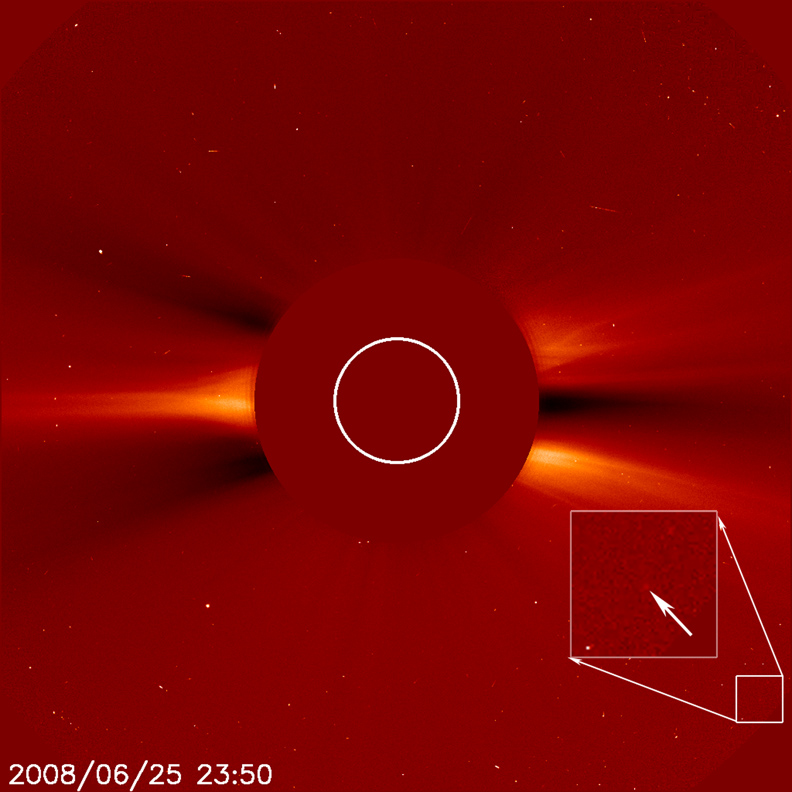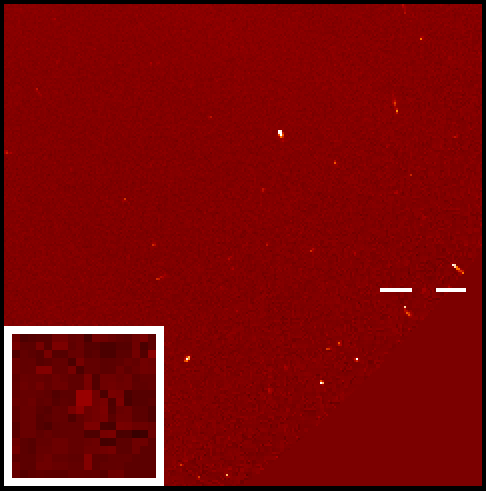SOHO celebrates 1500th comet discovery
 |
|
The Kreutz-Group comet SOHO-1500 was spotted on June 25th 2008 in images taken by the LASCO C2 coronagraph. High-Res TIFF image |
 |
|
Animation of SOHO's 1500th comet. SOHO-1500 is located between the two white horizontal bars and the insert in the lower left shows a magnification of the area containing the comet. Click on the image for a larger animation. |
It's the most successful comet catcher in history. SOHO has just reached a new milestone: It has discovered its 1500th comet, making it more successful than all the other discoverers of comets throughout history put together. Not bad for a spacecraft that was designed as a solar physics mission. SOHO's history-making discovery was made on June 25th 2008 by US-based amateur astronomer Rob Matson. This is Rob's 76th SOHO comet find.
When it comes to comet catching, the SOlar and Heliospheric Observatory has one big advantage over everybody else: its location. Situated between the Sun and the Earth, it has a privileged view of a region of space that can rarely be seen from Earth. From the surface of the planet, the space inside our orbit is largely obscured because of the daytime sky and so we only clearly see close to the Sun during an eclipse.
Roughly eighty-five percent of the SOHO discoveries, and also this one, are fragments from a once great comet that split apart in a death plunge around the Sun, probably many centuries ago. The fragments are known as the Kreutz group and now pass within 1.5 million kilometres of the Sun's surface when they return from deep space.
At this proximity, which is a near miss in celestial terms, most of the fragments are finally destroyed, evaporated by the Sun's fearsome radiation - all within the sight of SOHO's electronic eyes. One of twelve instruments, the Large Angle and Spectrometric Coronograph (LASCO) takes the pertinent images.
Of course, LASCO itself does not make the detections; that task falls to an open group of highly skilled volunteers who scan the data as soon as it is downloaded to Earth. When SOHO is transmitting to Earth, the data can be on the Internet and ready for analysis just 15 minutes after it is taken.
Enthusiasts from all over the world look at each individual image for a tiny moving speck that could be a comet. When someone believes they have found one, they submit their results to Karl Battams at the Naval Research Laboratory in Washington, DC, who checks all of SOHO's findings before submitting them to the Minor Planet Center, where the comet is catalogued and has its orbit calculated.
The wealth of comet information has value beyond mere classification. "This is allowing us to see how comets die," says Battams. When a comet constantly circles the Sun, so it loses a little more ice every time, until it eventually falls to pieces, leaving a long trail of fragments. Thanks to SOHO, astronomers now have a plethora of images showing this process. "It is a unique data set and could not have been achieved in any other way," says Battams.
All this on top of the extraordinary revelations that the solar physics mission has provided over the thirteen years it has been in space, observing the Sun and the near-Sun environment. "Catching the enormous total of comets has been an unplanned bonus," says Bernhard Fleck, ESA's SOHO Project Scientist.
Related Links


